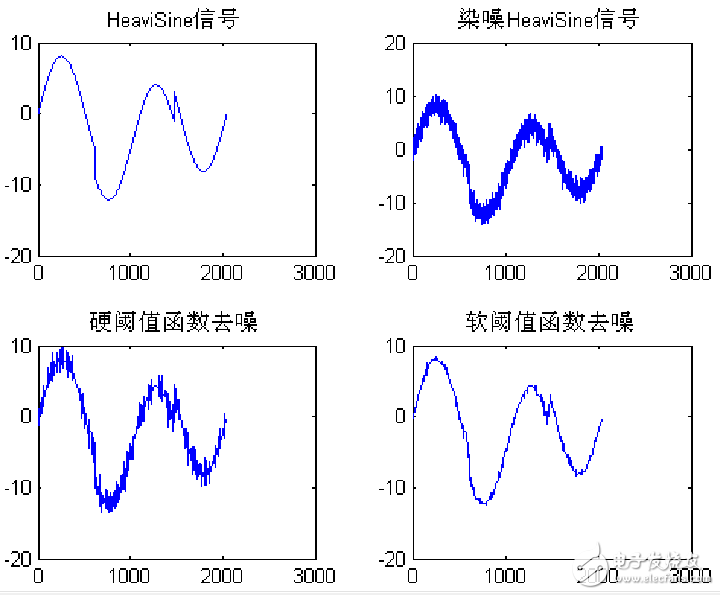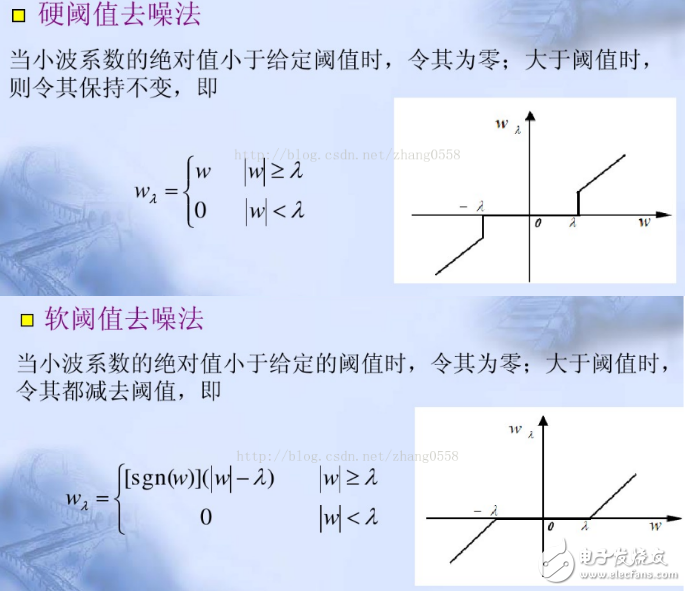Wavelet image denoising is based on the principle that the wavelet coefficients of signals and noise have different properties on different scales. The corresponding mathematical tools are used to construct the coefficient selection method to process the wavelet coefficients of the noisy signals. The wavelet denoising process uses wavelet decomposition to decompose the image signal into various scales, then removes the wavelet coefficients belonging to the noise in each scale, preserves and enhances the wavelet coefficients belonging to the signal, and finally uses the wavelet inverse transform to process the processed wavelet coefficients. The reconstructed image is denoised. The basic process is shown in Figure 1.

Figure 1 Wavelet threshold denoising process
In the above process, the selection of wavelet base and decomposition layer number j, the selection rule of threshold λ, and the design of threshold function are the key factors affecting the final denoising effect.
2, the choice of wavelet baseFor the less stable Blocks signal, the denoising effect of Haar wavelet is better than that of Sym8 wavelet.
For Doppler signals with good continuity and smoothness, the denoising effect of Sym8 wavelet is better. The ym8 wavelet function has a tight support set and has good continuity and symmetry, so it is more suitable for denoising a signal with better continuity.
Since the wavelet basis functions have their own characteristics when processing signals, and there is no wavelet basis function, the optimal denoising effect can be obtained for all types of signals. In general, the db wavelet system and the sym wavelet system are two families of wavelet bases that are often used in speech denoising.
3. Selection of decomposition scaleIn wavelet decomposition, the choice of the decomposition scale j is also a very important step. The larger the j is, the more distinct the different characteristics of noise and signal performance are, and the better the separation of the two is. On the other hand, the larger the decomposition scale, the larger the distortion of the reconstructed signal, and to some extent, the final denoising effect. Therefore, in the application, we must pay special attention to the contradiction between the two, and choose a suitable decomposition scale.
In the denoising of speech signals, since the daily vocal frequency of a person is generally between 85 and 1100 Hz, only the lowest layer frequency after decomposition is guaranteed.
It can be around 0-250HZ. For example, for a piece of audio with a sampling frequency of 8000 Hz, the maximum speech frequency should be 4000 Hz, and after the wavelet decomposition of scale 4, the lowest frequency coefficient is 0-250 Hz. At this time, threshold processing of each layer coefficient can ensure that the noise of the signal is sufficiently separated.
4, the choice of threshold functionTraditional threshold functions mainly include hard threshold functions and soft threshold functions. A commonly used HeaviSine test signal is processed with Gaussian white noise to obtain a noise-carrying HeaviSine signal. The soft-hard threshold function is used to perform the wavelet threshold denoising experiment on the noise-receiving signal. The sym8 wavelet base is chosen as the basis function of wavelet decomposition. The number of decomposition layers is 5 layers. The threshold value λ is selected by the hebration-based heuristic threshold selection function. The signal waveforms before and after denoising are shown in the following figure:

After determining the threshold of the wavelet coefficient (domain) of the Gaussian white noise, a threshold function is needed to filter the wavelet coefficient containing the noise coefficient to remove the Gaussian noise coefficient. The commonly used threshold function has a soft threshold and a hard threshold method. There are also a number of improvements and optimizations in the threshold function in many literature papers.

The hard threshold function is superior to the soft threshold method in the sense of mean square error, but the signal will generate additional oscillations, generate jump points, and have no smoothness of the original signal.
The overall stability of the wavelet coefficients obtained by the soft threshold estimation is better, so that the estimated signal does not generate additional oscillation, but it is better than the compressed signal, which will produce a certain deviation, which directly affects the degree of approximation of the reconstructed signal and the real signal.
E-cig as a substitute of tobacco mainly reminds people of its potential benefits for health. Four ingredients contain in the e-liquid : propylene glycol, glycerin vegetable, nicotine and food grade essence. Nevertheless, smoke from cigarette contains carbon monoxide, tar, arsenic, ammonia, and many other cyanide and acetone.
Advantage
- New ceramic self heating element, Uniform heating
- High reduction, Temperaturecan be accurately controlled
- Safety and Health, Worth a product,Natural and realistic taste,Factory Direct Sale
- Using proprietary technology,Quality assurance, trustworthy
- Oil leakage free, compact, pocket-sized, portable and easy to transport
-
So that smokers can smoke addiction, refreshing, to meet the psychological and physiological needs of smokers, and in line with the habit of smokers for many years.
-
Compared with rechargeable e-cigarettes and mechanical e-cigarettes, the price of disposable e-cigarettes is much lower, which is applicable to a wider range of customers than the first two. It is also the absolute truth for ordinary consumer groups to be cheap.
Wax Device Oem,Thc Wax Device Oem,Marijuana Wax Device Oem,High Cost Performance Wax Device
Shenzhen MASON VAP Technology Co., Ltd. , https://www.disposablevapepenfactory.com